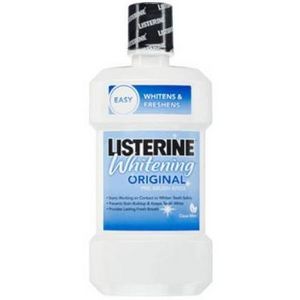12+ Whitening Secrets In Mouth Rinse For Faster Results

When it comes to achieving a brighter, more radiant smile, incorporating a mouth rinse into your oral care routine can be a game-changer. Mouth rinses, also known as mouthwashes, are liquid products used to rinse your mouth, reducing bacteria, bad breath, and plaque. For those seeking whiter teeth, some mouth rinses contain ingredients that can help remove stains and improve the appearance of your teeth. Here, we’ll delve into the world of mouth rinses designed to help with teeth whitening, exploring their ingredients, how they work, and tips for getting the most out of them.
Understanding Teeth Whitening Mouth Rinses
Teeth whitening mouth rinses typically contain mild abrasives, hydrogen peroxide, or other whitening agents that help break down stains on the surface of the teeth. These agents work by gently removing the outer layer of the stain or by oxidizing the molecular structure of the stain, making it less visible. When choosing a whitening mouth rinse, look for the following key ingredients:
- Hydrogen Peroxide: A common ingredient in teeth whitening products, including mouth rinses. It helps break down stains and whitens teeth over time.
- Carbamide Peroxide: Similar to hydrogen peroxide but breaks down into hydrogen peroxide and urea. It’s often used in at-home whitening kits and some mouthwashes.
- Sodium Bicarbonate (Baking Soda): Acts as a mild abrasive to help remove surface stains from teeth.
- Essential Oils (e.g., Peppermint, Eucalyptus): While not directly contributing to whitening, they can freshen breath and leave a clean feeling in the mouth.
12+ Secrets for Faster Results with Whitening Mouth Rinses
Choose the Right Formula: Select a mouth rinse that contains recognized whitening agents. Always check the ingredient list and look for products with the American Dental Association (ADA) Seal of Acceptance, which indicates the product has met certain standards for safety and effectiveness.
Use as Directed: Follow the instructions provided with your mouth rinse. Typically, you’ll swish the rinse around your mouth for 30 seconds to 1 minute before spitting it out. Be sure not to swallow the rinse.
Combine with Other Whitening Methods: For faster and more significant results, consider combining your mouth rinse with other whitening products like toothpaste, strips, or trays. However, always check with your dentist before starting any new whitening regimen.
Maintain Good Oral Hygiene: Brushing your teeth at least twice a day and flossing once a day can help maintain the whitening effects by preventing new stains from forming.
Limit Stain-Causing Foods and Drinks: Coffee, tea, red wine, and berries can stain teeth. If you consume these items regularly, consider using a straw to reduce contact with your teeth or rinsing your mouth with water afterward.
Stay Hydrated: Drinking plenty of water helps keep your mouth moist and can help rinse away some of the substances that can stain your teeth.
Visit Your Dentist Regularly: Regular dental cleanings can help remove deeper stains and maintain the health of your teeth and gums, which is essential for successful whitening.
Be Patient: Whitening results may take some time to become noticeable. Consistency is key when using a whitening mouth rinse.
Consider Professional Whitening: For more dramatic results, professional teeth whitening treatments available at dental offices can provide faster and more effective whitening.
Customize Your Routine: If you have sensitive teeth or gums, consider a mouth rinse designed for sensitivity or consult with your dentist for recommendations.
Monitor Progress: Take before and after photos to track the progress of your teeth whitening journey. This can help you stay motivated and adjust your routine as needed.
Learn About New Products: Keep an eye on dental care advancements and new products. Some newer mouth rinses may offer improved whitening capabilities or additional oral health benefits.
Additional Tips for Maximum Effectiveness
- Daily Consistency: Make using a whitening mouth rinse a part of your daily routine for consistent results.
- Interdental Care: In addition to regular brushing and flossing, consider using an interdental brush or water flosser to keep all areas of your mouth clean.
- Avoid Overuse: More is not always better. Using a whitening mouth rinse too frequently can lead to tooth sensitivity or gum irritation.
Conclusion
Whitening mouth rinses can be an effective addition to your oral care routine, helping to achieve a brighter, healthier smile. By understanding how these products work, following the tips outlined above, and maintaining a consistent oral hygiene regimen, you can maximize the whitening effects and enjoy a more radiant smile. Always remember to consult with a dental professional before starting any new oral care products, especially if you have concerns about tooth sensitivity, gum health, or the suitability of certain ingredients for your teeth. With the right approach, you can unlock the full potential of whitening mouth rinses and smile with confidence.
How long does it take to see results from a whitening mouth rinse?
+Results can vary, but you may start to notice improvements in the whiteness of your teeth after a few days to a week of consistent use. However, more significant results may take several weeks to achieve.
Can I use a whitening mouth rinse if I have sensitive teeth?
+Yes, but with caution. Look for mouth rinses labeled as suitable for sensitive teeth or consult with your dentist for recommendations. Start with a small amount or a lower frequency to gauge your sensitivity.
Do whitening mouth rinses replace regular toothpaste and brushing?
+No, they do not. Whitening mouth rinses are meant to be used in addition to your regular brushing and flossing routine. They can help with whitening and provide additional oral health benefits but do not replace the need for thorough toothbrushing and interdental cleaning.

